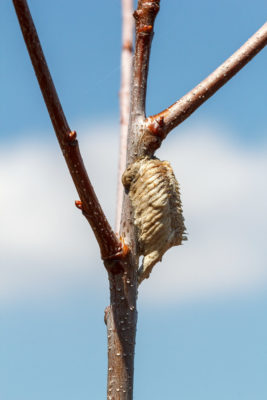Polk County’s Most Wanted – Carolina Mantid (Stagmomantis carolina)
Have you seen the Carolina Mantid (Stagmomantis carolina)?
Conserving Carolina and botanist/ecologist David Campbell need your help in locating this month’s “Polk County’s Most Wanted—Animal,” one of our many fascinating and important species of insects, the Carolina Mantid (Stagmomantis carolina). Polk County’s Most Wanted is a community science initiative with a new challenge each month, in which you can expand the scientific understanding of the flora and fauna of Polk County.
Where should I look for Carolina Mantid?
A not uncommon, but nonetheless cryptic element of our insect fauna, the Carolina Mantid frequents fields, wooded areas, and gardens. With an overall distribution throughout the eastern United States, from southern New York and west to the Rocky Mountains, this insect may also be found ranging into parts of Central America.
The Carolina Mantid is most conspicuous in late summer or early fall, as it reaches its final dimensions as an adult, after growing since spring emergence.
How do I identify Carolina Mantid?
With a length between 4-6 centimeters, the Carolina Mantid is smaller than some of its more familiar relatives. Clothed in colors of brown, green, and gray (with males more often being brown), the Carolina Mantid blends easily into the background of the vegetation where it lives.
What other clues can I look for when trying to find Carolina Mantid?
During the winter months, when much of the obscuring vegetation is not present, one may also search purposefully for mantid egg cases (technically known as an ootheca). Egg cases are approximately three quarters to one inch in length, and are of a uniform tan coloration. Egg cases typically contain dozens to hundreds of eggs.

Careful examination of low shrubs, trees, grasses, fence posts and the like will often reveal the presence of one or more of these egg cases. If you happen to find a Carolina Mantid egg case on your property-count yourself fortunate, as this insect is a beneficial predator of many common garden pests.
As with other mantids in our region, this species feeds on various species of insects, such as bees, flies, wasps, and others. Cannibalism, especially among siblings (and mates!), is not uncommon either.
What can you do?
If you think that you have found Carolina Mantid, or its ootheca, in Polk County, please contact Pam Torlina at Conserving Carolina by email at [email protected], and if you can, provide a clear photo, for a definitive confirmation.
For More Information
Visit Conserving Carolina’s website, conservingcarolina.org/polk-most-wanted, for more information about “Polk County’s Most Wanted” and to download and print a “Pocket Guide” with all of the “Most Wanted” plants, animals, and habitats that you can be on the lookout for!
Also, a culmination of David Campbell’s seven years in the field documenting the rare and significant flora and fauna in Polk County have been compiled in a book titled, “An Inventory of the Significant Natural Areas of Polk County, North Carolina.” The document can be downloaded for free on Conserving Carolina’s website at conservingcarolina.org/polk-county-inventory, or a hard copy can be purchased, at cost, on Amazon.
Conserving Carolina, your local land trust, is dedicated to protecting land and water, promoting good stewardship, and creating opportunities for people to enjoy nature. Learn more and become a member at conservingcarolina.org.
